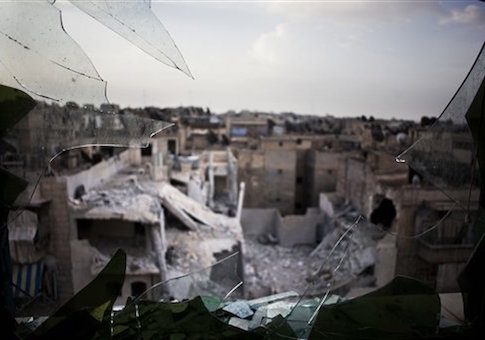At least 53 highly trained Iranian fighters have been killed in Syria as of mid-November, causing political strain in the Iranian government, which has sought to downplay and hide these deaths from public view, according to disclosures from an Israeli security organization.
Iranian members of the country’s Revolutionary Guard Corps have shifted in recent months from serving in an advisory role to becoming full-fledged fighters alongside forces backing embattled President Bashar al-Assad in Syria. At least 2,000 Iranian fighters are now believed to be operating in the country.
This had led to a "sharp increase in the number of Iranian dead" and suggests that the Islamic Republic has moved to the "front line" of the pro-Assad ground offensive, according to information published by the the Meir Amit Intelligence and Terrorism Information Center, an Israeli think-tank and intelligence organization.
Intelligence compiled by the center indicates that trained Iranian fighters have taken to the front lines, with at least 53 corps fighters having been killed as of Nov. 15, including senior commanders. The uptick in the number of those killed fighting for Assad has caused internal tension in Tehran and forced the government to launch public campaigns aimed at galvanizing public support for its war effort.
"The heavy losses incurred by Iran in Syria have required the Iranian leadership to provide justification for Iran's military involvement in Syria and explanations for the high number of Iranians killed," the Meir Amit center wrote in a recent brief on the situation. "To that end the regime instituted a media campaign to enlist public opinion to support Iranian involvement in Syria and obviate any possible criticism."
The effort has consisted of stoking sectarian tensions between Shiite and Sunni Muslims and emphasizing Iran’s "fundamental commitment to continue its support for the Assad regime and its benefits for Iranian national interests," according to the brief.
As the number of Iranians killed in action continues to grow, citizens of the country "are beginning to wonder" if the campaign is "worthwhile," according to the report, which notes that internal government fissures have begun to erupt over the situation
"As the number of Iranians killed rises, and as Iranian military involvement in Syria becomes deeper, public criticism and [internal] protest against continuing involvement will increase," it notes.
Additionally, Iranian leaders have raced in recent days to discredit reports and rumors and the death of its senior military leader in Syria.
Earlier this week, for instance, Iranian state-controlled media outlets rushed to dismiss reports that Quds Force Commander Qassem Soleimani, who is leading the regime’s efforts in Syria, had been killed in a strike.
"General Soleimani is alive and safe," a senior corps official told Iran’s Fars News Agency following reports of his death. "Such rumors have been spread by the terrorists due to the heavy blows that they have received from the Syrian forces led by the Iranian military advisers in different parts of Syria in the past two months and given General Soleimani's key role in their defeats."
The military source declined to provide information of Soleimani’s whereabouts in Syria, claiming that his shifting position is kept "top secret" in order to protect "the secret nature of his mission."
However, a top Iranian general was killed late last month during clashes in central Syria. At least eight top officials have been confirmed dead.
"The large number of Iranians killed in a short time, and the strikingly large number of officers (including high-ranking officers), would seem to indicate that IRGC fighters are on the front line of the current ground offensive," according to the Meir Amit brief.
This includes fighters in the IRGC’s infantry, armored corps, and special forces. An Iranian-Syrian operations center also has been set-up in Syria’s Aleppo region to "coordinate and command the attack forces," according the brief.
The specialized nature of the Iranian fighters additionally points to "an Iranian effort to send trained fighters with special skills to carry out special missions, possibly including gathering intelligence."
The uptick in deaths are an indication that Iranian forces are becoming strained as a result of the intervention in Syria and other nations, such as Iraq, Yemen, and Lebanon.
Michael Ledeen, a former State and Defense Department consultant, noted that Iran is suffering casualties among a range of its military branches.
"A considerable number of Iranians are being killed and maimed in the regime's desperate effort to save the Assad regime," he said. "That includes military fighters and officers from the Revolutionary Guards and Hezbollah as well as intel officers from MOIS. This is very unpopular in Iran. Traditionally the regime got Arabs to fight for them; this time their own men are on the firing line."
Michael Rubin, a former Pentagon adviser and expert on rogue regimes, explained that Iran has been using the cash assets it received as part of the recently reached nuclear accord to "double down" on its war effort in Syria.
"The good news is that they are losing enough people in Syria that Iranians are taking notice despite the refusal of the Iranian press to cover fully the Iranian bloodbath in Syria," Rubin said.
